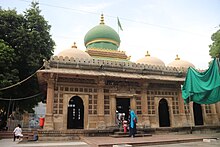Wajihuddin Alvi
Wajihuddin Alvi | |
|---|---|
| Personal | |
| Born | 1490s Champaner, Gujarat |
| Died | 1580 (aged 89–90) Ahmedabad |
| Resting place | Wajihuddin's Tomb |
| Senior posting | |
| Teacher | Muhammad Ghawth |
| Successor | Hashim Pir Dastagir |
Students
| |
| Part of a series on Islam Sufism |
|---|
 Tomb of Abdul Qadir Gilani, Baghdad, Iraq |
| Ideas
|
|
| List of sufis |
| Topics in Sufism |
 Islam portal Islam portal |
|
Shah Wajihuddin Alvi Gujarati (Persian: شاه وجیه الدین علوی گجراتی), also known the epithet Haider Ali Saani (Persian: حیدر علی ثانی), was an Islamic scholar and Sufi in the Shattari tradition.
Life
Wajīh al-Dīn ʿAlawī Gujarātī was born in Ahmedabad in 1504 into a family of Sufi scholars and juristsm, who were patronised by the sultans of Gujarat. In 1528 he founded the ʿAlawī Madrasa which was Ahmedbad's most notable Islamic learning center for over a century and a half. In his youth he was a member of several Sufi orders, but most importantly he was initiated into the Shaṭṭāriyya order by Muhammad Ghawth Gwāliyārī. Despite being a Sunni and a proponent of Hadith, he professed the unity of God, man, and the universe and taught dhikr or repitition of God's names. When it came to Islamic sectarianism, he professed "total peace", and opposed discrimination against the Mahdawi movement. During the Mughal conquest of Gujarat in 1572-1573, he harboured the sons and supporters of the former sultan of Gujarat, Muẓaffar Shāh III. Due to this he was summoned by the Mughal emperor Akbar before being let go. He died in his madrasa in 1590.[1]
Works
Wajihuddin Alvi is reported to have written books in Arabic and Persian[2]
- Hashiya Alvi Ala Tafsir Baydawi حاشية العلوي على تفسير البيضاوي
- Sharh Nuzhat Al-Nazar شرح نزهة النظر للكجراتي مع نخبة الفكر للعسقلاني
- Hashiya Alvi ala Sharh al-Jami https://archive.org/details/hashiya-alvi-ala-sharh-al-jami
- Risala Qushji Sharh Qushji
- Aidah Haqiqat Sharh Haqiqat Muhamadi ايضاح حقيقت شرح حقيقت محمدي
Death and burial

He died in 1580 CE.[3] He is buried in a memorial tomb in Khanpur, Ahmedabad, that was built by his disciple Syed Murtuza Khan Bukhari, the eleventh (1606–1609) governor of Ahmedabad during the reign of Jahangir.[4][5][6]
References
- ^ Kugle, S. (2010). "Alawī, Wajīh al-Dīn". In Fleet, K.; Krämer, G.; Matringe, D.; Nawas, J.; Stewart, D.J. (eds.). Encyclopaedia of Islam Three Online. Brill.
- ^ Khayr al-Din al-Zirikli; Zirikli (2002). Al-Alam. Islam Kotob. p. 110.
- ^ Nūrulḥasan Hāshimī; Valī (1986). Wali. Sahitya Akademi. p. 13.
- ^ Trimingham, John Spencer and Voll, John O. (1998). The Sufi orders in Islam. Oxford University Press USA. pp. 97–98. ISBN 0-19-512058-2.
{{cite book}}: CS1 maint: multiple names: authors list (link) - ^ Achyut Yagnik (2 February 2011). Ahmedabad: From Royal city to Megacity. Penguin Books Limited. p. 42. ISBN 978-81-8475-473-5.
- ^ Gazetteer of the Bombay Presidency: Ahmedabad. Government Central Press. 1879. p. 278.
dastur khan mosque.
Further reading
- tazkiratul wajeeh by Syed Husaini Peer Alvi
- Shah Wajeehuddin Alvi Gujrati Ahwal -o- Aasar by Abdur Rahman Parwaz Islahi
- Khulasa-tul Wajih by Ahmed bin Muhammad Al-Farouqi
- Life and works of Sheikh Wajihuddin Alavi Gujrati by Mohammad Khalid











